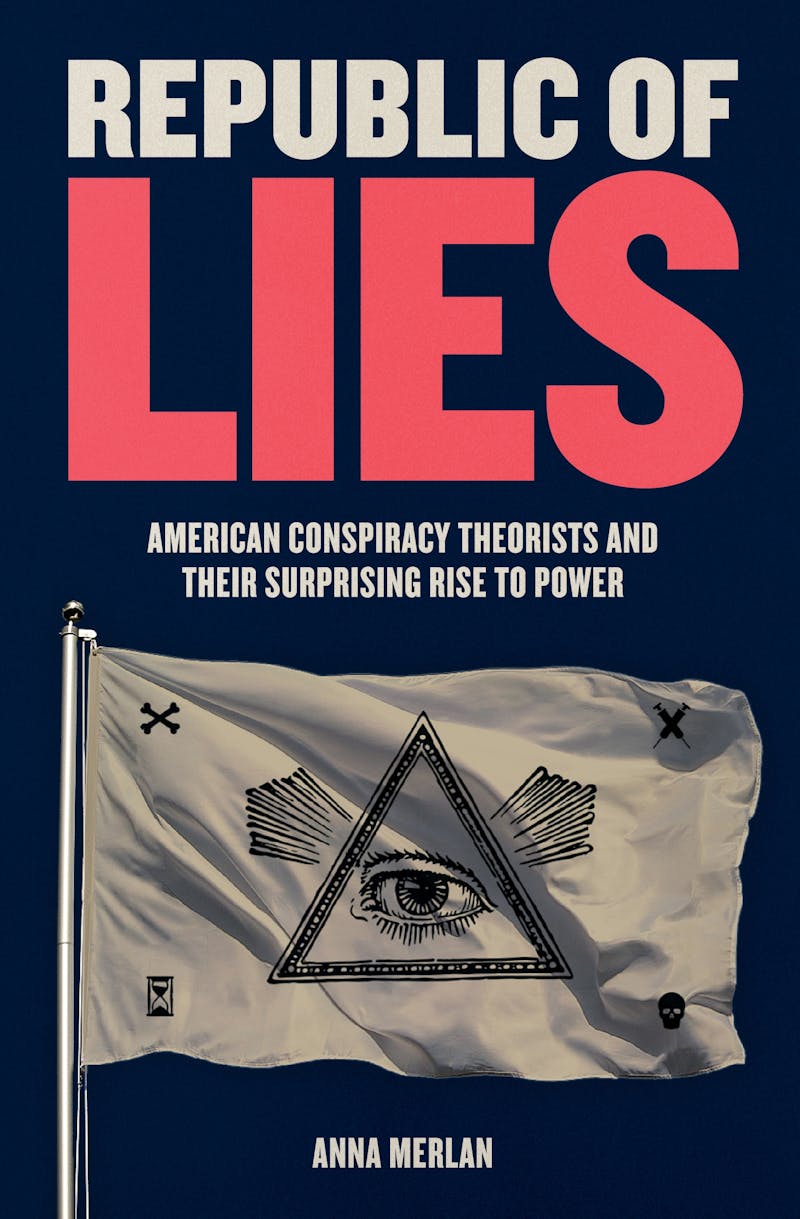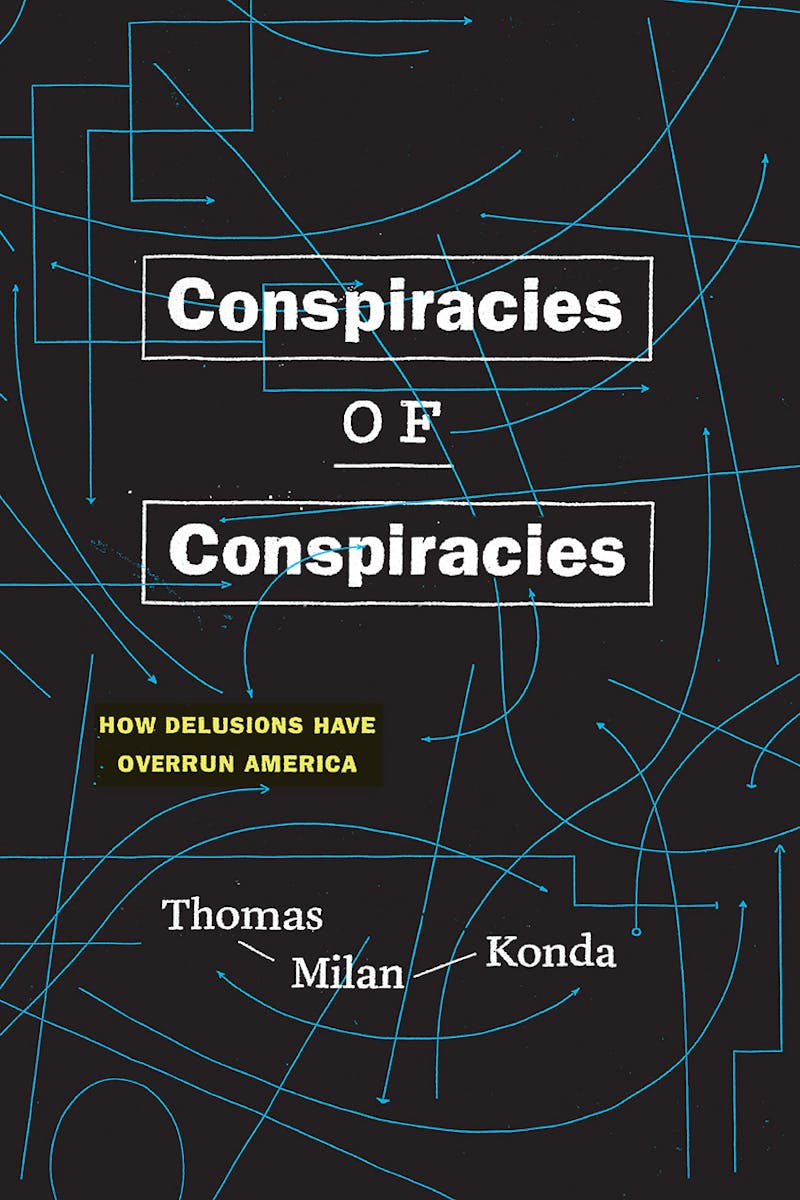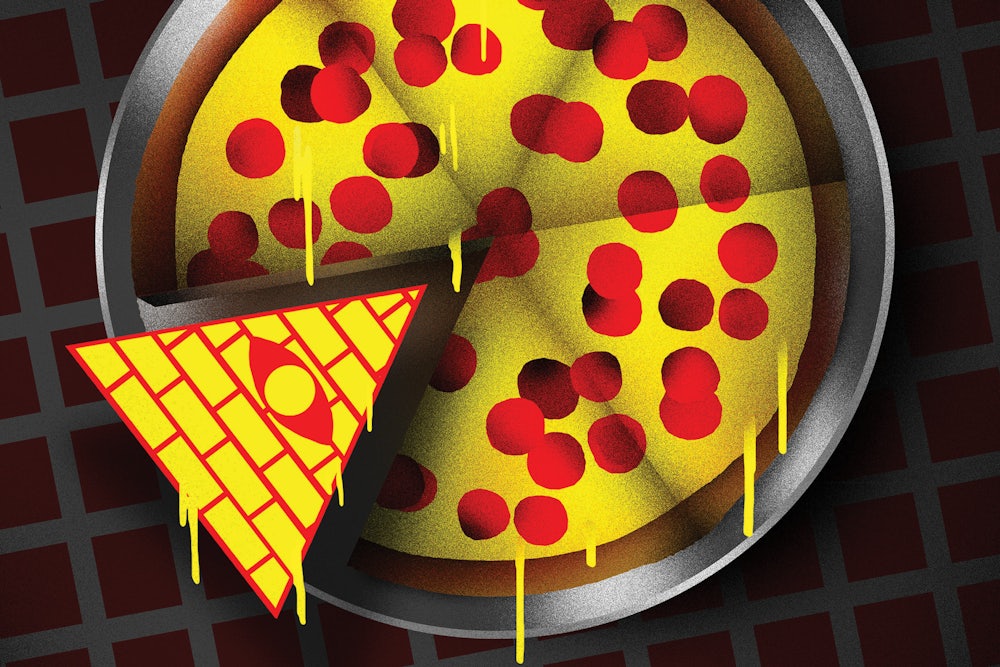At the end of 2016, in the wake of Donald Trump’s election, The Oxford English Dictionary made “post-truth” its word of the year, Merriam-Webster picked “surreal,” and Dictionary.com chose “xenophobia.” Loath to put too fine a point on it, the American Dialect Society went with “dumpster fire.” At least in recent times, official words of the year have tried to capture the political and social anxieties of their moment, and the ascent of Trump—a onetime birther who espoused noxious falsehoods about immigrants, appeared brazenly unconcerned with ethical boundaries, and openly associated with the notorious conspiracist and Infowars founder Alex Jones—seemed to portend the entry of once-fringe ideologies into the mainstream.


Much like their candidate, many of Trump’s most visible and fervent supporters, drawn largely from the nativist right wing, were disposed to wild conspiracy theories. The election year saw the explosion of Pizzagate, the theory that Democratic Party officials (along with the artist Marina Abramovic) were operating a child sex trafficking ring out of an unassuming pizza restaurant in Washington, D.C. From Pizzagate developed QAnon, whose proponents speculated, among other claims, that former Democratic National Committee chair Debbie Wasserman Schultz had hired MS-13 to assassinate DNC staffer Seth Rich. That, in turn, resurrected the “Clinton body count,” a long-running belief that Bill and Hillary had, between them, engineered the deaths of dozens of associates and political enemies.
It would be easy to see this deluge of misinformation, half-truths, and outright fabrication as an exclusive product of the Trump era. After all, the new president and his administration fanned the flames of conspiracism and mistrust by railing against “fake news” and recharacterizing their own dubious propaganda as “alternative facts.” Yet today’s climate of paranoia has much deeper roots. In her book Republic of Lies, the investigative journalist Anna Merlan uncovers the origins of several modern conspiracies, ranging from the frenzy around Pizzagate to the belief that the CIA deliberately created and spread aids among African Americans. Meanwhile, political scientist Thomas Milan Konda’s book, Conspiracies of Conspiracies, maps out a family tree of the sprawling, frequently anti-Semitic theories that the United States has nurtured stretching back to the eighteenth century.
What emerges from both books is a pattern: Conspiracism surfaces in sync with the ups and downs of a nation, taking root in its excesses and its crises, and flourishing particularly among groups who feel economically or politically marginalized. People end up susceptible to outlandish ideas not because they’re inordinately foolish or ill-intentioned, but because they’re living in times of enormous socioeconomic instability and political discord. Put another way, conspiracy theories aren’t eroding democracy so much as they signal that a democracy is already decaying. Combating them effectively has less to do with sounding the alarm than with taking up a broader fight for economic equality and for robust, democratic social institutions.
For the uninitiated, Merlan’s book is a riveting tour through the tangles of some of the most prominent conspiracy theories in circulation today. Blending first-person reporting from a variety of conspiracist gatherings with a measured survey of the existing research on conspiracy theories, she explores why and how demonstrably untrue ideas germinate. Behind each quack theory she finds groups of people who feel powerless or alienated in some significant way. “Conspiracy theories tend to flourish especially at times of rapid social change,” Merlan notes. Such theories, far-fetched though they may seem, often “outline a path to a better life and provide hope for the future.”
One prime example is redemption theory, or the belief that the government is hoarding a vast, secret stockpile of money that the average citizen, equipped with the right set of codes and know-how, can seize. A popular claim among redemption theorists is that the federal government deposits $630,000 into a secret bank account for every child issued with a birth certificate in the United States. That secret account creates a “straw man” persona meant to serve as collateral for the monetary system in lieu of a gold standard; the key to accessing the fortune is hidden in the text of U.S. commerce regulations. As a result, believers in redemption theory are intensely hostile to the federal government and see the IRS and other financial institutions as shadowy behemoths denying them what they’re rightfully owed. “There’s a huge inequity in society,” Sean David Morton, a leading redemption theory proponent (and self-proclaimed UFO expert and psychic), tells Merlan. “People are just being raped by the banks.”
Morton’s forays into redemption theory included filing false tax returns and selling his redemption schemes to other people for thousands of dollars. In 2017, he was charged with conspiracy (ironically) to defraud the government. Though he belongs to a “colorful tradition of American hucksters, seekers, and strivers,” Merlan ultimately sees the logic in his scheme. “Although redemption theory targets desperate people,” she writes, “it also takes advantage of two facts: The tax code is impossibly, impenetrably hard to understand; and there is always someone, somewhere who has found a way to beat it.” (That someone, of course, is generally a billionaire or a corporation equipped with robust legal and accounting teams.)
The same uneasy relationship between half-truths and wild speculation tends to lurk beneath even the most outlandish, vitriolic conspiracy theories, like the better-known Pizzagate. In the spring of 2017, Merlan attended a Pizzagate rally, where a small band of committed believers—child abuse survivors, alt-right opportunists, evangelical Christians, and a father with a child holding a sign that read IF YOU SEE ME WITH JOHN PODESTA, CALL THE POLICE—gathered in front of the White House to demand an “unbiased” investigation into the Democrats’ supposed pedophilia ring.
The Pizzagate outcry took root during the fever-pitched news cycle of 2016, exploding online after the WikiLeaks release of Clinton campaign manager John Podesta’s emails. A handful of citizen detectives poring over the emails deduced that they contained coded references to child sex trafficking among high-level Democratic Party officials, and that the headquarters of this operation was the basement of the D.C.-area pizza restaurant Comet Ping Pong. (Comet has no basement.) Over the next month, the theory became so potent that in December 2016, one adherent stormed Comet Ping Pong with a loaded AR-15, intending to liberate the child sex slaves that he believed were held prisoner. Needless to say, he found no captives; luckily, the few shots he fired went through a door and into some computers, respectively. (“The intel on this wasn’t 100 percent,” he would later tell The New York Times.)
Yet, like redemption theory, Pizzagate was believable to some people because large-scale abuses and high-level cover-ups actually do happen. The events of the next year only confirmed this, when Harvey Weinstein was publicly outed as a serial predator whose decades of abuse were enabled by a network of associates. (“Is Pizzagate all still fake?” one speaker at the rally Merlan attended triumphantly asked in the wake of the Weinstein revelations.) Crank ideas, in other words, are often the proverbial stopped clocks, and conspiracy theories tend to gesture toward very real inequalities and abuses of power. “Anyone who tells you we can always easily distinguish fictitious plots from real ones,” Merlan writes, “probably hasn’t read very much history.”
This doesn’t make conspiracy theories any less dangerous. Paranoid delusions provide the underpinnings of various extremist predilections and serve to encourage attacks on vulnerable groups. The far right has, for instance, despicably accused the victims of Sandy Hook and other mass shootings of being paid “crisis actors” dispatched by the government as part of an elaborate scheme to confiscate citizens’ guns; those accusations, spread via publications such as Infowars, have made the grieving families targets of vicious harassment. (Seth Rich’s family also has endured constant threats and abuse.) The mass murderers Anders Breivik, Dylann Roof, and the Pittsburgh synagogue shooter Robert Bowers each subscribed to a number of racist and anti-Semitic conspiracy theories.
The foundations of several of today’s most noxious conspiracy theories were decades—even centuries—in the making. One early American conspiracy theory, propagated by religious officials in New England during the late eighteenth century, held that the Illuminati had orchestrated the French Revolution and were planning to import Jacobinism to the United States. The New England ministers’ sermons against the Illuminati, which warned of their impending threat to an American “way of life,” helped set the blueprint for the next several eras of American conspiracism. (To this day, the short-lived Bavarian secret society remains a preoccupation of British conspiracy theorist David Icke, who contends that its members are giant lizards.)
By the beginning of the twentieth century, the fear of a surreptitious foreign influence on the American way of life had fused with anti-Semitism to form the backbone of many modern-day conspiracy theories: the idea of a “hidden hand” or secret government made up of Jews that pulls the strings behind the scenes of national governments and other institutions. The longstanding belief that the Rothschild family controls every bank in the world is one such conspiracy theory descended from the “hidden hand” theory; the idea that there exists a supra-national body bent on authoritarian global rule, often called the New World Order, is another. As Conspiracies of Conspiracies painstakingly demonstrates, this strand of anti-Semitism birthed, among other twentieth-century conspiracy theories, the belief that Jews had engineered the Russian Revolution, the New Deal, and the civil rights movement as part of an international communist conspiracy. (There’s still no satisfying answer to how Jews managed to become both omnipotent international financiers—the ur-capitalists—and Bolsheviks.)
Conspiracy theories, both anti-Semitic and otherwise, tend to wax and wane with periods of social upheaval. During the 1930s, Konda writes, the “worldwide economic depression, the rise of fascism, and the dramatic political shift into the New Deal” spawned a host of hidden hand conspiracy theories, including the contention that FDR was a secret Jew, and that hundreds of thousands of Jewish communists were planning to enter the United States via the Mexico border to “rape every woman and child that is left unprotected.” Similarly, the Vietnam War and the Watergate scandal, followed by bombshell reports of government abuses in the 1970s, fostered a deep distrust of authority. That period saw conspiracy theories about John F. Kennedy’s assassination, moon landing denialism, and fears of a fictitious “King Alfred Plan,” a CIA plot to round up African Americans and send them to concentration camps in the event of race riots.
Nearly every period of turmoil in American history has generated its own host of conspiracy theories. Is conspiracism in the Trump era really more widespread than it was in the 1920s, when Henry Ford printed and distributed 500,000 copies of the anti-Semitic tract Protocols of the Learned Elders of Zion, or during the McCarthy era, when hundreds were imprisoned and thousands more fired from their jobs or blacklisted on suspicion of harboring communist sympathies? Does the proliferation of 4chan threads dedicated to proving Hillary Clinton’s involvement in a secret pedophilia ring signal a significant departure from the Satanic panic of the 1980s, when the media and the public alike became convinced that preschool teachers were sexually abusing toddlers as part of underground Satanic rituals? The problem with making an exhaustive catalog of the craziest theories entertained by Americans over the last 200 years is that today’s almost seem to pale by comparison.
Extinguishing conspiratorial tendencies that plainly surface again and again will require more than just the public’s awareness that those tendencies exist. This is where short-term solutions to righting “post-truth” notions often falter. The media’s rigorous fact-checking of politicians’ statements does help sometimes, but its effects do not tend to last. Public trust in both the federal government and the media is now at a record low, which means that news campaigns designed to correct falsehoods, like The Washington Post’s Pinocchio system, are likely to have diminishing returns. And as Scientific American recently reported, the collapse of local newspapers has exacerbated political polarization, as citizens increasingly rely on national coverage, which prioritizes partisan talking heads and emphasizes political differences.
A vast number of conspiracy theories hinge on the existence of a subjugated yet honorable “people” against a corrupt and scheming “elite,” and, as it happens, so does populism. That conspiracism and populism are often found together probably comes as no surprise to anyone who has paid attention to Donald Trump’s supporters in any detail. But it does suggest that fighting conspiracy theories will mean understanding and taking seriously the causes of the rise of populism in the United States and Europe over the last few years. Addressing the conditions that enable conspiracism, rather than the content of the conspiracism itself, points the way toward quashing it. In Merlan’s view, real and permanent solutions will include “genuinely representative elections, better education in science and media literacy, a less moneyed system of democracy, true and permanent government transparency.”
A March 2019 report from the Pew Research Center revealed that the majority of Americans now believe that their living conditions will continue to decline over the next three decades, including a widening gap between the rich and poor; the ongoing erosion of stable, well-paying work; and increasing political animosity. A large portion of the public foresees a weaker economy, more expensive health care, environmental degradation, and a difficult old age. Such prospects don’t bode well for the future of factuality.
“Conspiracy theories are for losers,” the political scientists Joseph Uscinski and Joseph Parent once wrote. They meant literal losers: people who have lost elections and culture wars, but also jobs, homes, and economic prospects. Without a serious political and economic realignment in the next few years, that group will only include more and more of us.
